
Bill and Foot of a Short-tailed Albatross
"Diomedea brachyura. Short-tailed Albatross. Bill 5.00 or 6.00 inches long, with long, with moderately…

Sooty Albatross
"Phoibetria fuliginosa. Sooty Albatross. Plumage ordinarily uniform sooty-brown; quills and tail blackish…
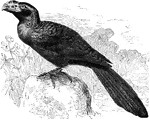
Smooth-billed Ani
"Crotophaga ani. Smooth-billed Ani. Black Witch. Savanna Blackbird. Bill smooth or with a few transverse;…
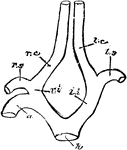
Carotid Arteries of Birds
"h, root of aorta; 1, arch of aorta, to the right side; li, left innominate; ri, innominate; ls, left…
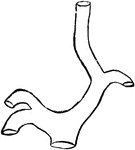
Carotid Arteries of Birds
"h, root of aorta; 1, arch of aorta, to the right side; li, left innominate; ri, innominate; ls, left…
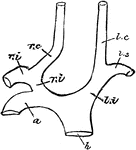
Carotid Arteries of Birds
"h, root of aorta; 1, arch of aorta, to the right side; li, left innominate; ri, innominate; ls, left…
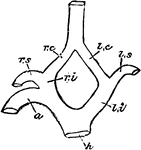
Carotid Arteries of Birds
"h, root of aorta; 1, arch of aorta, to the right side; li, left innominate; ri, innominate; ls, left…
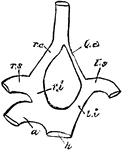
Carotid Arteries of Birds
"h, root of aorta; 1, arch of aorta, to the right side; li, left innominate; ri, innominate; ls, left…
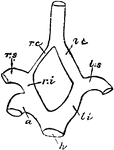
Carotid Arteries of Birds
"h, root of aorta; 1, arch of aorta, to the right side; li, left innominate; ri, innominate; ls, left…

Least Auk Adult
"Simorhynchus pusillus. Least Auk. Knob-nosed Auk. Bill small and simple. but stout for its length,…
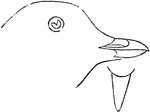
Least Auk Adult
"Simorhynchus pusillus. Least Auk. Knob-nosed Auk. Bill small and simple. but stout for its length,…
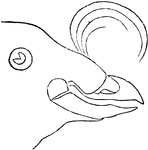
Crested Auk in Summer
"Simorhynchus cristatellus. Crested Auk. Snub-nosed Auk. Bill fundamentally small and simple, compressed-conic,…

Horn-billed Auk in Summer
"Ceratorhina monocerata. Unicorn Auk. Horn-bill Auk. Adults in summer: Bill orange-yellow. Culmen and…

Crested Auk in Winter
"Simorhynchus cristatellus. Crested Auk. Snub-nosed Auk. A beautiful crest of 12-20 slender feathers…

Horn-billed Auk in Winter
"Ceratorhina monocerata. Unicorn Auk. Horn-bill Auk. In winter: Bill orange-yellow. Culmen and base…
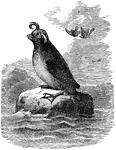
Crested Auk
"Simorhynchus cristatellus. Crested Auk. Snub-nosed Auk. The whole plumage otherwise sooty - more brownish-black…

Great Auk
"Alca Impennis. The Great Auk. A great white oval spot between eye and bill. Hood and mantle dark; under…

Parroquet Auk
"Simorhynchus psittaculus. Parroquet Auk. Pug-nosed Auk. Adult in summer with the nasal saddle, moulted…
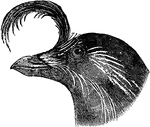
Whiskered Auk
"Simorhynchus pygmaeus. Whiskered Auk. Red-nosed Auk. Bill (dry) orange-red, more salmon color or yellow…

Young Horn-billed Auk
"Ceratorhina monocerata. Unicorn Auk. Horn-bill Auk. Young: Bill like that of adults in winter, lacking…

Young Whiskered Auk
"Simorhynchus pygmaeus. Whiskered Auk. Red-nosed Auk. Bill very small and weak, much compressed. No…

Auks and Cormorants
" A needle rock tenanted by Cormorants, Auks, etc." Elliot Coues, 1884 The rock is protruding from the…

Least Auks
"Simorhynchus pusillus. Least Auk. Knob-nosed Auk. Bill small and simple, but stout for its length,…

Avocets Head and Foot
"Another small family, characterized by the extreme length of the slender legs, and the extreme slenderness…
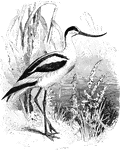
Avocets
"Recurvirostra. Avocets. Bell slender, more or less recurved, then the upper mandible hooked at the…

Barbs
"The arrangement shown in fig. 22, where a, a, a, a, are four barbs in transverse section, viewed from…
Single Barbule
"Fig. 21. -A single barbule, baring barbicels and hooklets; magnified; after Nitzsch. ...barbicels (another…
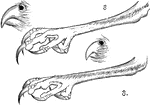
The Beaks and Claws of a Burrowing Owl
"Speotyto. Burrowing Owls. tarsi long, about twice as long as the middle toe without its claw, very…

Oriole Bill
"Icterus. Orioles. Bill averaging as long as head (more or less); very acute, sometimes decurved." Elliot…

Pelican Bill
"North American White Pelican. Bill and feet ordinarily yellow; much reddened in the breeding season,…
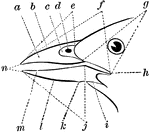
The Parts of a Bird Bill
"Fig. 26 - Parts of a Bill. a, side of upper mandible; b, culmen; c, nasal fossa; d, nostril; e(see…
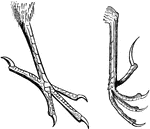
Typical Passerine Bird Feet
"Fig. Typical passerine feet. The right hand fig. is plectrophanes lapponicus." Elliot Coues, 1884
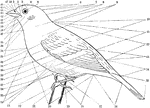
Topography of a Bird
"fig. 25 - Topography of a Bird. 1, forehead (frons). 2, lore. 3, circumocular region. 4, crown (vertex).…

Bittern
"Botaurus. Bittern. Bill moderately longer than head, shorter than tarsus, which is shorter than middle…

The Bill of a Bittern
"Botaurus. Bittern. Bill moderately longer than head, shorter than tarsus, which is shorter than middle…
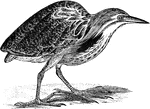
American Bittern
"Botaurus mugitans. American Bittern. Indian Hen. Stake-driver. Bog-Bull. Plumage of the upper parts…

Red-winged Blackbird
"Agelaeus phoeniceus. Blackbird. marsh Blackbird. Red-winged Blackbird. Red-and-buff-shouldered marsh…

Yellow-headed Blackbird
"Xanthocephalus icterocephalus. Yellow-headed Blackbird. Male: Black, including lores and small space…
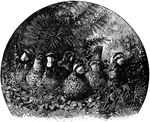
Bob-white Family
"Ortyx virginiana. Virginia Partridge or "Quail". Bobwhite. Male: Forehead, superciliary line, and throat,…

Male and Female Bob-whites
"Ortyx virginiana. Virginia Partridge or "Quail". Bobwhite. Male: Forehead, superciliary line, and throat,…
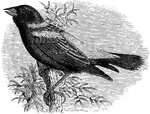
Bobolink
"Dolichonyx oryzivorus. Bobolink. Meadow-wink. Skunk Blackbird (Northern States), Reed-bird (Middle…
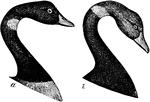
Black Brant Head
"Bernicla nigricans. Black Brant. Bill, feet, and claws black; iris brown. Head and neck all around,…
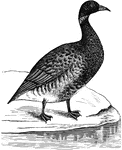
Black Brant
"Bernicla nigricans. Black Brant. Bill, feet, and claws black; iris brown. Head and neck all around,…
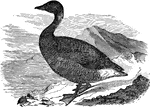
Common Brant
"Bernicla brenta. Brant Goose. Bill, feet, and claws black; iris brown. Head and neck all around, and…

The Foot of a Bridled Foot
"Sterna anaisthetikos. Bridled Tern. The foot of a Bridled Tern; Tarsus .85; middle toe the same, with…
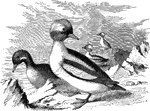
Buffleheads
"Clangula albeola. Buffle-head. Butter-ball. spirit-duck. Dipper. Bill with nostrils rather behind than…
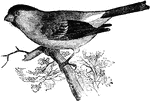
Cassin's Bullfinch
"Pyrrhula cassini. Cassin's Bullfinch. Above, clear ashy-gray; below, cinnamon-gray; rump and under…
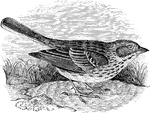
Bay-winged Bunting
"Pooecetes gramineus. Grass Finch. Bay-winged Bunting. Vesper-bird. Above, grayish-brown, closely and…
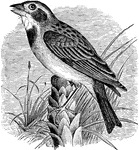
Black-throated Bunting
"Spiza americana. Black Throated Bunting. Above, grayish-brown, the middle of the back streaked with…

Lark Bunting
"Calamospiza bicolor. Lark Bunting. White-winged Blackbird. Black, with A large white patch on the wings;…
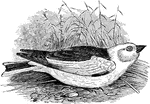
Snow Bunting
"Plectrophanes nivalis. Snow Bunting. Snowflake. Pure white; the bill, feet, middle of back, scapulars,…

Butcher-bird
"Lanius borealis. Great Northern Shrike. Butcher-bird. Great Grey Shrike. Above, clear bluish-ash, blanching…

Butcher-bird Head
"Lanius borealis. Great Northern Shrike. Butcher-bird. Great Grey Shrike. Above, clear bluish-ash, blanching…
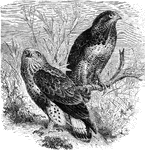
American Rough-legged Buzzard
"Archibuteo lagopus sancti-johannis. American Rough-legged Buzzard. "Black Hawk" Adult: Too variable…

Red-tailed Buzzard
"Buteo borealis. Red-tailed Buzzard. "Hen Hawk". Upper surface of tail rich chestnut, with white tip…
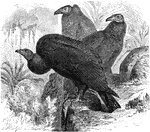
Turkey Buzzard
"Cathartes aura. Turkey Buzzard. Blackih-brown, grayer on the wing-coverts; quills black, ashy-gray…
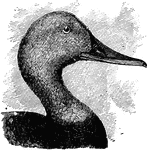
Canvas-back Head
"Fuligula vallisneria. Canvas-back. Adult male: The head close-feathered. Bill high at the base and…
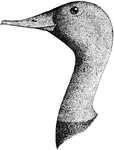
Large Canvas-backs Head
"Fuligula vallisneria. Canvas-back. Adult male: The head close-feathered. Bill high at the base and…
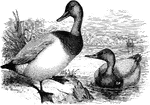
Canvas-backs
"Fuligula vallisneria. Canvas-back. Adult male: The head close-feathered. Bill high at the base and…

Phalanges of Caprimulgine
"Fig. 41 shows phalanges of caprimulgines foot, where the ratio is 2, 3, 4, 4." Elliot Coues, 1884